Introduction to Back and Bicep Workout
There are no definite rules for effective back and bicep training. Some prefer to train the two muscle groups separately, while others enjoy the classic back and bicep workout.
You do not need a lot of knowledge or ideas for efficient training in either case, but you need to know the fundamentals. For instance, a notable benefit of training your back and biceps together is the fact that these muscle groups love working together. Another benefit is that both muscle groups look great when you develop them and significantly impact how your upper body looks and feels. Plus, not to mention that strengthening them plays a vital role in your overall strength and athleticism.
Back and Bicep Anatomy: The Basics You Need to Know About these Muscle Groups
The back is a complicated collection of muscle groups with various roles. This group features many small and large muscles that work and produce movements like standing, pulling, bending your torso to the side and front, and extending your back (1). There are five primary muscle groups:
- Latissimus dorsi
- Upper, middle, and lower trapezius
- Teres major and minor
- Erector spinae
- Rhomboids
If you are unsure of what muscles you are using when doing a specific exercise, an app like Hevy can help. It shows visuals of the exercises showing what muscles are being worked.
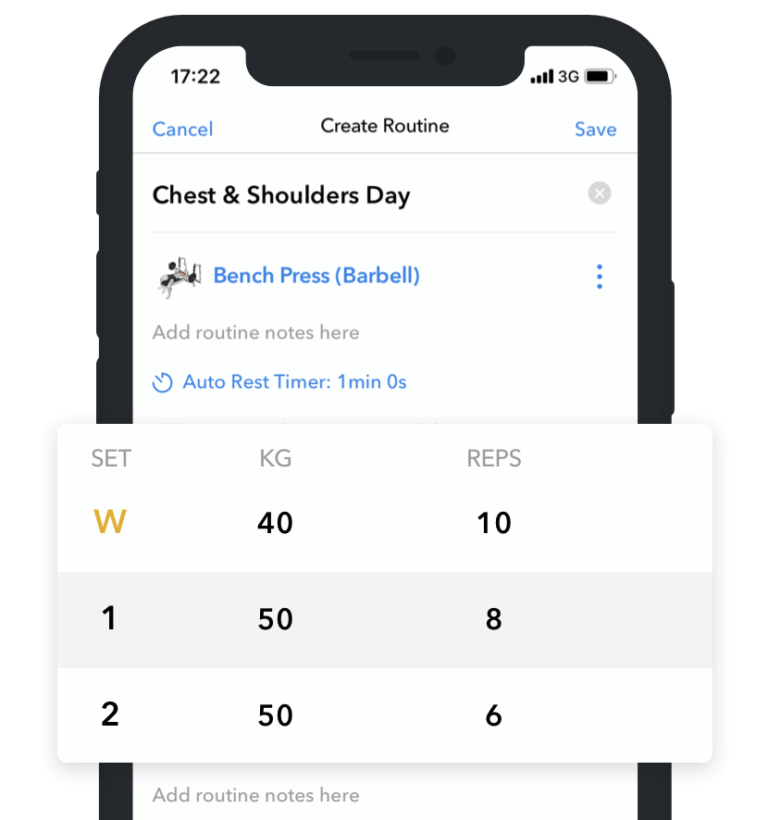
Hevy – Workout Tracker
Create your own back and bicep workouts with Hevy, and track your progress.







Hevy – Workout Tracker
Create your own back and bicep workouts with Hevy, and track your progress – for free
As you can imagine, training these muscle groups is not as simple as doing a couple of rowing exercises and calling it a day. It is essential to consider how we set up our workouts, which we’ll go over below. Relative to the back, your biceps are a much smaller and simpler muscle group to understand (2). As its name suggests, the bicep is a two-headed muscle. You have a shorter inner and a longer outer head. Both heads work together to produce wrist supination and elbow flexion.
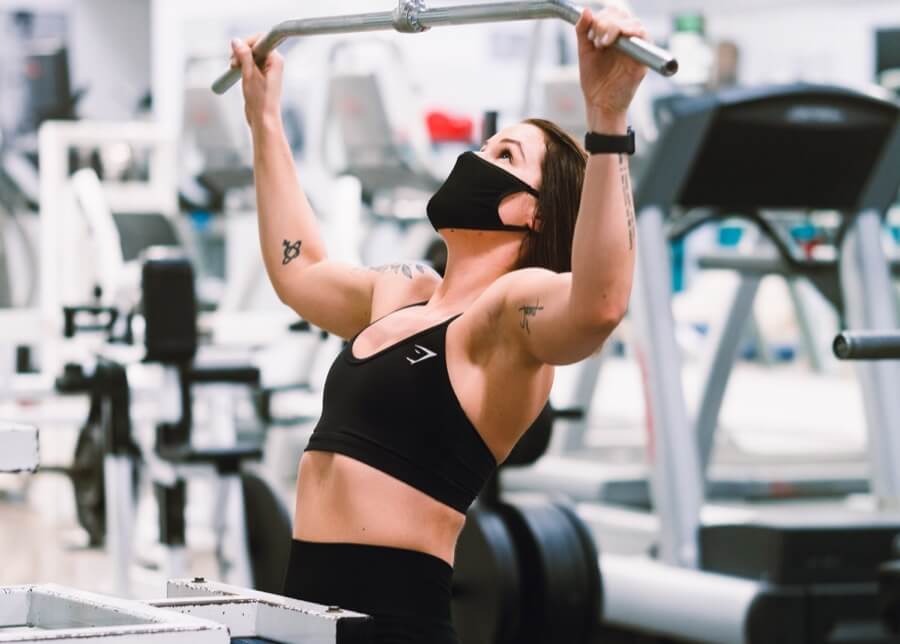

You also have the brachialis within the bicep area – a deeper muscle that also produces elbow flexion (3). Since it lies underneath the biceps, it’s not entirely visible. At a low BMI (body fat index), you can see a part of it right next to the outer bicep head, at the side of your upper arm.
2 Of the Best Back and Bicep Workouts You Can Do for Mass and Strength (A & B)
Our goal was to create two similar back and bicep workouts that complement one another. As you’ll see in a moment, both workouts achieve the essential outcome: train your back and biceps. We have structured the two workouts in a way that allows them to complete each other and results in balanced muscular development.
Find and track Workout A and Workout B on the Hevy app.
Workout A
Workout A is the first weekly back and bicep work and features mostly vertical pulling exercises. We begin with a compound movement and slowly go down the list of assisting exercises that emphasize the back and give the trapezius some direct work. We then finish off with a bicep exercise that primarily emphasizes the long outer head of the bicep, created from the grip width.
- Pull-Ups – 3 sets of 5-10 reps
- Lat Pulldowns – 3 sets of 12-15 reps
- Cable Lat Pullover – 3 sets of 12-20 reps
- Dumbbell Shrugs – 3 sets of 10-15 reps
- EZ Bar Bicep Curls (Narrow Grip) – 3 sets of 8-12 reps
Exercise 1 – Pull-Ups
The pull-up is among the most effective bodyweight exercises you can do to strengthen and develop your back and biceps. Beyond that, the movement builds full-body stability and fantastic grip strength.
Muscle groups: Lats, Rhomboids, Erector Spinae, Lower Trapezius, Biceps, Forearms, and Core
Equipment: Pull-Up Bar
1. Grasp the pull-up bar firmly with an overhand grip and hands slightly wider than shoulder-width.
2. Bring your chest out, engage your abs, and squeeze your glutes.
3. Take a breath and pull through your elbows. Go up as high as you can – ideally until your chin is over the bar.
4. Lower yourself slowly, fully engaging your back muscles on the way down. Exhale near the bottom.
Exercise 2 – Lat Pulldowns
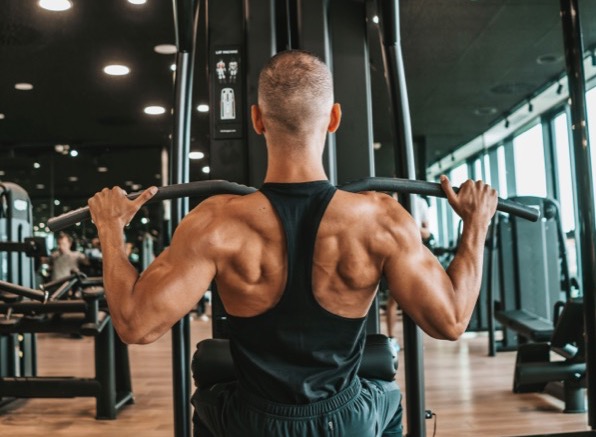

The lat pulldown is an excellent exercise that closely resembles pull-ups (4). Its advantage is that you can adjust the resistance depending on your strength and focus on training your lats incredibly well.
Muscle groups: Lats, Rhomboids, Lower Trapezius, Biceps, and Forearms
Equipment: Lat Pulldown Machine
1. Select the load and adjust the thigh path so it allows you to fit your legs firmly underneath.
2. Grab the attachment, sit down, and secure your thighs under the pad.
3. Bring your chest out, lean back slightly, and take a breath.
4. Pull down through your elbows until the bar reaches your upper chest.
5. Hold the contraction for a moment and slowly release it as you exhale on the way up.
Related article: 8 Dumbbell Lat Exercises for a Broad and Muscular Back
Exercise 3 – Cable Lat Pullover
The cable lat pullover is one of the best exercises you can do to isolate your lats. Thanks to the long-range motion and lack of bicep engagement, you can fully emphasize your lats and make them burn.
Muscle groups: Lats, Lower Trapezius, Triceps, and Abs
Equipment: Cable Machine and Handle Attachment
1. Select the load, grab the attachment and take a couple of steps back to pull the weight off its stack.
2. Rotate your arm so your palms face forward and bend forward as you keep your arm straight. Take a breath, engage your abs and make sure your back is neutral.
3. Pull the weight down and back as you move your hand toward your hips.
4. Squeeze your lats at the bottom and slowly release the handle as your arm travels forward and up. Keep your elbow extended at all times.
Exercise 4 – Dumbbell Shrugs
The dumbbell shrug is an excellent exercise for emphasizing and building your traps. You can use heavy enough dumbbells to cause significant overload and force both sides of your full body to work independently.
Muscle groups: Trapezius (upper, middle, and lower), Rhomboids, Erector Spinae, and Forearms
Equipment: Pair of Dumbbells
1. Grasp a pair of dumbbells using an even-handed grip – your palms facing your thighs.
2. Bring your shoulders back, engage your abs, and squeeze your glutes.
3. With your arms straight, shrug both dumbbells up by engaging your upper back muscles. A helpful mental cue would be to touch your ears with your traps (which is impossible but helpful).
4. Bring the dumbbells up as high as you can, hold the top for a moment, and release as you exhale.
Exercise 5 – EZ Bar Bicep Curls
The EZ bar curl is a fantastic bread-and-butter bicep exercise because you can overload it with tons of weight. Due to the bar’s shape, it’s also better for your wrists, especially if you feel pain from straight bar curls.
Muscle groups: Biceps and Forearms
Equipment: EZ Bar and Weight Plates
1. Grasp the EZ bar with hands in a narrow grip and stand tall. Your knuckles should be against your upper thighs.
2. Bring your shoulders back, engage your abs, and take a breath.
3. Curl the bar up as you keep your torso and elbows steady.
4. Go up until your wrists are slightly higher than your elbows, hold the position for a moment, and slowly release the barbell.
5. Exhale on your way down.
Related: 8 Isolation and 7 Compound Bicep Exercises For Big Arms
Workout B
This workout perfectly complements the previous one because it predominantly features horizontal pulling. With the previous one, we greatly emphasized lat development (width). Here, the goal is to highlight the other muscle groups that make up the back and focus on thickness. The bicep exercise is also different, which provides an additional stimulus, and we have some rear deltoid work in place of trap training.
- Bent-Over Barbell Row – 3 sets of 6 to 10 reps
- Single-Arm Dumbbell Row – 3 sets of 8 to 12 reps
- Seated Cable Rows – 3 sets of 15 reps
- Seated Dumbbell Hammer Curl – 3 sets of 10 to 15 reps
- Cable Rope Face Pulls – 3 sets of 12 to 25 reps
Exercise 1 – Bent-Over Barbell Row
The bent-over barbell row is an excellent compound exercise that trains the entire back and makes it thicker (5). Thanks to your torso position, you also heavily involve and strengthen your lower back and abs, as both muscle groups work hard to keep you stable.
Muscle groups: Lats, Rhomboids, Erector Spinae, Abs, Glutes, Trapezius (upper, middle, and lower), Biceps, and Forearms
Equipment: Barbell and Weight Plates
1. Bend forward and grasp onto the bar with an overhand grip at roughly shoulder level.
2. Without lifting the bar, bring your shoulders back and bend your knees.
3. Push through to raise the bar off the floor. Ensure that your back is straight, pull your shoulders back, engage your abs, and take a breath.
4. Row the bar up and aim for it to touch slightly above your belly button.
5. Once you tap your stomach, slowly release the bar as you keep your torso in position. Exhale near the bottom.







Hevy – Workout Tracker
Create your own back and bicep workouts with Hevy, and track your progress.







Hevy – Workout Tracker
Create your own back and bicep workouts with Hevy, and track your progress – for free
Exercise 2 – Single-Arm Dumbbell Row
The single-arm dumbbell row is an excellent back accessory movement because it allows you to train one side at a time, offers a fantastic range of motion, and you can still overload the action with more resistance.
Muscle groups: Lats, Rhomboids, Erector Spinae, Abs, Trapezius (mostly the middle and lower portions), Biceps, and Forearms
Equipment: Dumbbell and something to use for balance (e.g., Gym Bench)
1. Position the dumbbell next to the gym bench, bend forward and grab it. Place your free hand atop the bench for balance, bring your shoulders back, and push through your knees to lift the dumbbell off the floor.
2. Your feet should be staggered for balance. Orient yourself so that your torso is almost parallel to the ground, engage your core, and make sure your back is straight by bringing your shoulders back.
3. Take a breath and row the dumbbell as high as you can – ideally until your elbow is at torso level.
4. Hold for a moment, squeezing your lat, and slowly release the dumbbell without allowing your shoulder to protract at the bottom.
5. Exhale as the weight goes down.
Exercise 3 – Seated Cable Rows
Seated cable rows are a great back assisting exercise because you don’t have to worry much about balance, the range of motion is excellent, and you can overload your back with a lot of weight (6).
Muscle groups: Lats, Rhomboids, Erector Spinae, Abs, Trapezius (mostly the middle and lower portions), Biceps, and Forearms
Equipment: Seated Cable Machine
1. Select the load and sit on the machine. Lean forward, grab the attachment with both hands, move back a bit, and place your feet on the machine’s platform.
2. Bring your shoulders back, make sure your torso is upright, and maintain a slight bend in your knees.
3. Take a breath and pull through your elbows until the attachment taps your upper stomach lightly.
4. Release the weight as you engage your back and keep your torso in a stationary position. Exhale near the end of the repetition.
Exercise 4 – Seated Dumbbell Hammer Curl
Hammer curls are fantastic for training your biceps, but they are also great for emphasizing your forearms and brachialis. Plus, since you’re doing them in a seated position, this stops you from using momentum or full-body movement to curl the dumbbells.
Muscle groups: Long head of Biceps and Forearms
Equipment: Pair of Dumbbells and Gym Bench
1. Retrieve dumbbells and sit on a gym bench. With both dumbbells to your sides and palms facing in, bring your shoulders back and take a breath.
2. Curl both dumbbells simultaneously as you keep your elbows in a steady position. Go up until your wrists are slightly higher than your elbows.
3. Pause for a moment and slowly release the weights until your elbows are straight. Exhale near the bottom.
Exercise 5 – Cable Rope Face Pulls


The face pull is an excellent exercise for emphasizing your rear deltoids. Experts also suggest that doing face pulls regularly is incredibly beneficial for shoulder health.
Muscle groups: Shoulders (primarily the posterior head), Rhomboids, Traps, and Biceps
Equipment: Cable Station and Rope Attachment
1. Adjust the pulley to a top position and select the load. Grab the rope attachment with both hands, making sure your thumbs face the ceiling.
2. Taking a few steps back to lift the weights off its stack, bring your shoulders back, and take a breath.
3. Pull the rope in the direction of your face as you split it open.
4. Hold for a moment, making a conscious effort to engage your rear deltoids and release the attachment as you exhale.
A Popular Workout Plan that Combines and Bicep Training
We love the push-pull legs split (PPL) and recommend it often because:
- It’s simple to program
- You have many scheduling options
- You get to have fun and engaging workouts
- It works for beginners to experts
Within the Push- Pull Legs (PPL) split, you have three different workouts:
- Push, where you train the muscles involved in pressing activities – chest, shoulders, and triceps
- Pull, where you work the pulling muscles – namely, your back and biceps
- Legs, where you train your entire lower body – glutes, hamstrings, quads, adductors, and calves
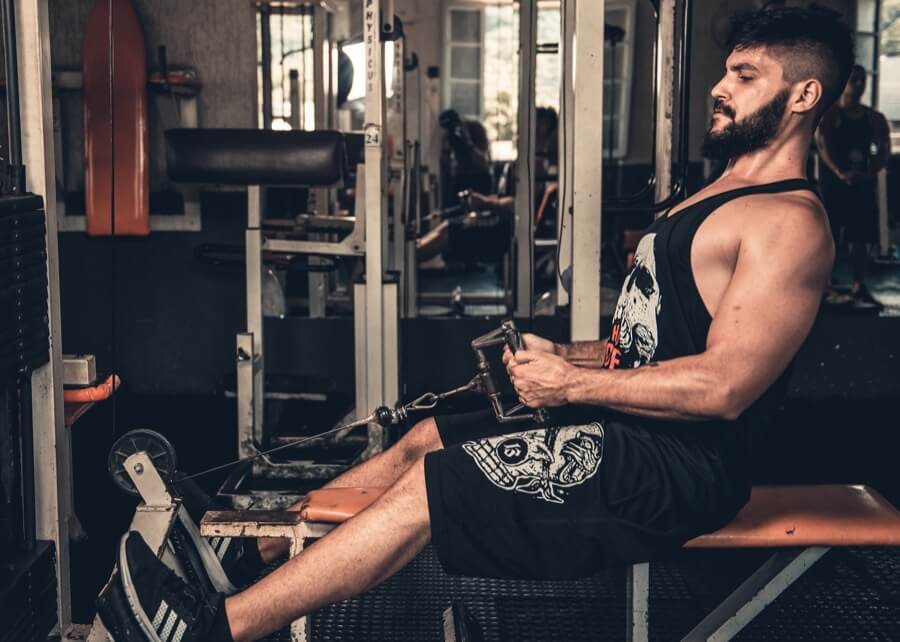

As far as back and biceps workouts go, the push-pull legs split is excellent because the second workout is dedicated to these two muscle groups. And, depending on your fitness level, you can train your back and biceps once or twice per week. For example, you can follow a three-day split:
Monday – Push
Tuesday – Off
Wednesday – Pull
Thursday – Off
Friday – Legs
Saturday & Sunday – Off
But you can also train as many as six days per week. Like so:
Monday – Push
Tuesday – Pull
Wednesday – Legs
Thursday – Push
Friday – Pull
Saturday – Legs
Sunday – Off
The split is good because it allows you to spread your weekly training more evenly and not have to do tons of exercise per workout. You can even create a 7 or 8 day split workout if you have more time to dedicate to the gym. If you have limited time to work out, try full-body workouts. Plus, you can use it to have the A and B workout we looked at above.
Conclusion
There are plenty of ways to have an effective back and bicep workout. We can pick from many exercises and combine them in all sorts of ways. But, as you saw above, putting together a productive workout takes a bit of thought. It’s not just about making a list of some exercises and getting started. Be mindful of the movements, sequence them, and understand how they work together inside a good training program.
To help track your workouts using a tracking app can be an efficient way to stay on target to reach your goals.







Hevy – Workout Tracker
Create your own back and bicep workouts with Hevy, and track your progress.







Hevy – Workout Tracker
Create your own back and bicep workouts with Hevy, and track your progress – for free
Workouts A and B complement each other and allow for optimal back and bicep training. We could have chosen many different exercise combinations, but this one is great precisely because each movement plays a role in the equation. For example, workout A focuses on vertical pulling and includes some direct trapezius work. In contrast, workout B is about horizontal pulling and allows you to train your rear deltoids directly. Together, they allow for complete back training where nothing gets overlooked.
Should you choose to try the above workouts (or borrow the concept), the push-pull legs split will allow you to organize your weekly training more efficiently.
Frequently Asked Questions
How often should I train my back and biceps?
Research suggests that training volume is what matters most for muscle growth (7). Still, we recommend a frequency of twice per week because it allows you to spread your weekly training better and takes advantage of the transient muscle protein spikes that occur after each workout (8).
Can I use a partial range of motion on some sets?
Some people suggest that using a partial range of motion can be beneficial for causing metabolic stress, which can lead to more growth. There could be some truth there, but we advocate a full range of motion for back and biceps training, especially for beginners and intermediate-level trainees.
Help! I can’t feel my back working while I pull or row. What should I do?
Many trainees struggle to establish a good mind-muscle connection with the back. One effective tactic is to think of your hands as mere hooks for the weight. Instead, focus on pulling through your elbows. This suggestion should hopefully help you engage your back better.
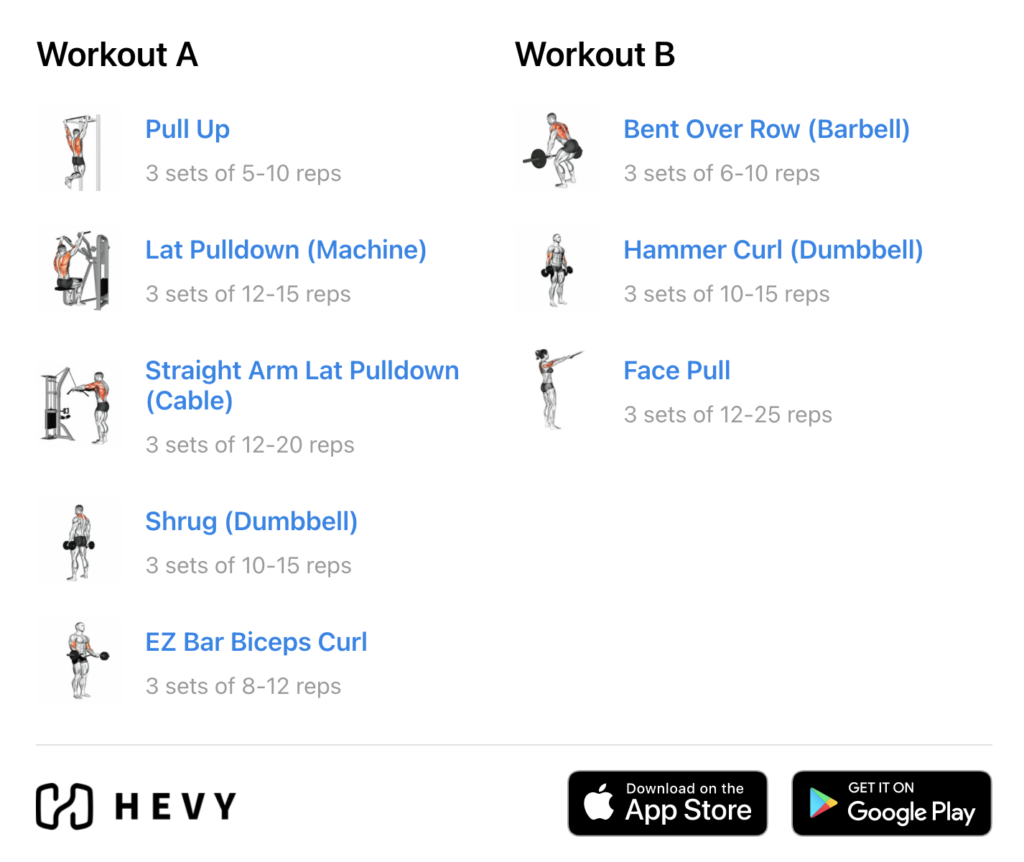
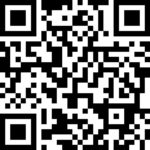
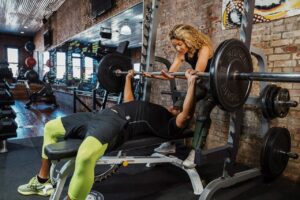
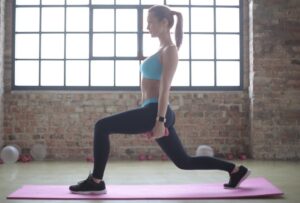
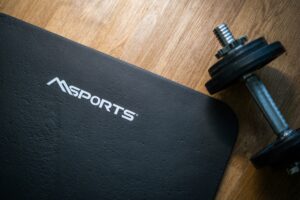
2 thoughts on “Back and Bicep Workouts for Building Strength”
Can you please do a blog on cutting and bulking?
Great idea, we will definitely write about this at some point!